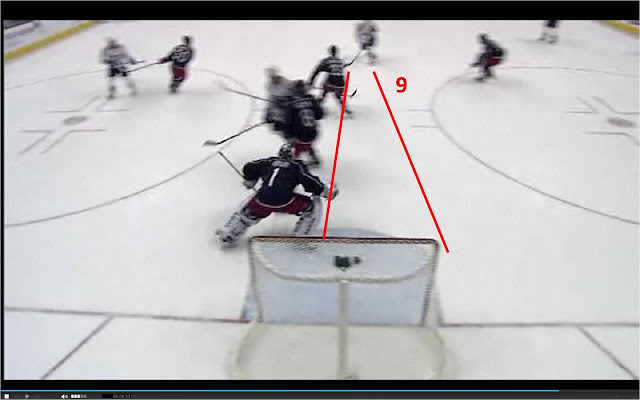I love this goal. Seriously, I LOVE this goal. We've previously looked individually at either when faceoff wins, or lack of defensive speed, results in goals. This week's goal by J.P. Dumont is a perfect example of how a designed play can exploit them both, and, only nine seconds apart, result in a game winning goal. So lets break down one heckuva game winner (and streak snapper) in this edition of AOAG.
[Note: I'm going to try something new in this post and put the football analogies in brackets, that way people who want to read them can, but those who don't can easily skip over. As always, questions, comments, etc. are welcomed at preds101@comcast.net, or on twitter @preds101].
The Goal
The Breakdown
1. The play starts off in a seriously offensive formation. Shea Weber (D, #6) and J.P. Dumont (RW, #71) are lined up far to the right of the faceoff... an aggressive move given the fact that the faceoff is in the defensive zone
[Football fans, this is an offensive formation because it allows for breakaways, but provides the goalie less protection. A rough football analogy would be a spread offense. A typical formation would have Weber directly behind the center taking the faceoff, and the right wing standing closer to the faceoff circle, either to the right or behind the winger].
2. Notice where the feet are positioned relative to the hash-marks on the circles. Jason Arnott's (C, #19), feet in the right red circle. He is lined up on the mark, as close to the Blues player as possible. Steve Sullivan, (LW, #26), on the other hand, is a foot off the mark. This allows for Sully to move quickly, without getting tied up with the Blues defender.
[Think of the difference as a defenseive CB who lines up on the line for bump-and-run coverage, versus a cornerback who gives the WR a few yards.]
3. Now the logic behind the initial formation unfolds.
A. Marcel Goc (C, #9) wins the faceoff, and passes it behind him to a "seemingly" empty space.
B. Sullivan moves toward the puck, unobstructed, to gain possession
C. Weber moves back in anticipation of a pass.
D. Dumont is off to the races down ice, down the right boards.
E. Arnott is breaking down ice down the left boards.
4. Weber gets the pass from the now obstructed Sullivan. He will pull the puck from his backhand to his forehand to make the pass up to Dumont. Dumont is wide open and moving up ice. However, the Blues defender is following Dumont toward the right sideboards.
5. Notice how this play has left the left side of the ice cluttered with players, especially Blues players. Meanwhile, the Preds, Puck, and Play are all moving toward the right and out of the zone. Arnott has already slipped by his man, who was likely not expecting the player from that position to break out of the zone.
6. Weber makes the pass to Dumont, who has plenty of room to maneuver.
7. Dumont has the puck and speed for a two-on-two breakaway. Even if nothing else happens, this is a great transition from defense to offense.
[Transitioning from defense-to-offense quickly and effectively is a critical but difficult-to-measure team skill. Sort of akin to the ability to convert third downs, if your team can't do it, they are not going to win alot of games].
8. Arnott has blown by the forwards, and is not manned up with the other Blues defenseman, Eric Brewer (D, #4). He was so quick down ice that he is forced to slow down a touch to avoid being offsides.
8.1 (Oops, two "8"s, anyway, above...) It's amazing to see on the video, but tough to see in the still frames: Dumont really puts on a burst of speed here. He decides to go toward the boards with the puck. In doing so he gets the defender, Darryl Sydor, (D, 44, age 37) turned around.
[If Dumont didn't have that extra speed to get passed the Blues defender, Sydor, what you would have seen is Dumont dumping the puck into the zone deep, a.k.a. "dump-and-chase"].
9. The speed burst gives forces Sydor to turn from skating backwards to skating forwards. That move, plus Dumont's speed, will give Dumont a step on the defender.
10. The other defender, Brewer, is still forced to respect Arnott, who is coming into the zone and trailing Dumont. If it were not for Arnott, the defender would be able to make a more aggressive play on Dumont.
11. Dumont's extra speed meant that the blues defender, Sydor, was unable to make a good play on the puck. The speed also meant that the defender was in no position to take down Dumont with a body check. Sydor's only remaining option? To take a diving poke-check at the puck. This is not a position the defender wants to be in. Sure enough, the diving poke-check misses.
Additionally, Brewer, the lower defender, realizes his defensive partner is in trouble, and moves over to help on Dumont.
12. Brewer is unable to get over in time. Dumont has "built a wall" so that his body is positioned between himself and Brewer. Dumont is able to get a shot off that isn't the best shot in the world, but it is a goal. The game winner, no less. Sydor can only look on and realize his lack of speed resulted in a goal. Had it puck not gone in, Arnott was close behind to attempt to pick up the rebound.
Conclusion
What a fantastic play. An important face-off win on a drawn up "get-down-ice-quick" play results in a great individual move and a goal. Its these types of goals that are hard to appreciate full speed at the game, or on TV, but really give you a sense of how impressive the game is. Until next time, lets go Preds!

















































 vs.
vs. 




